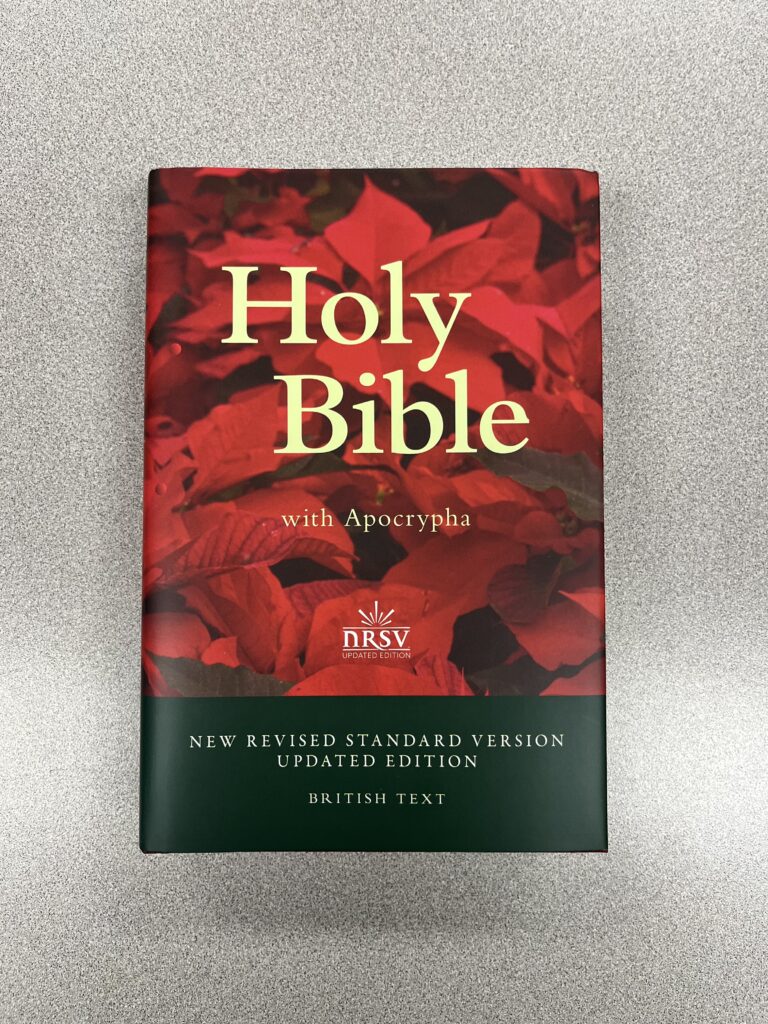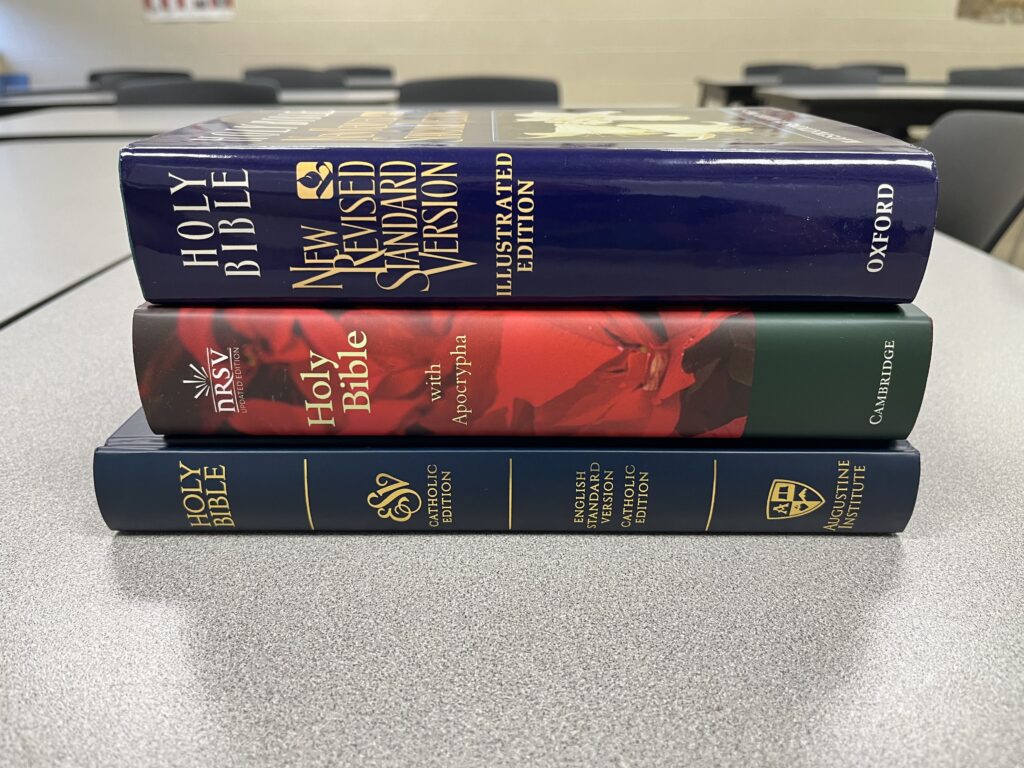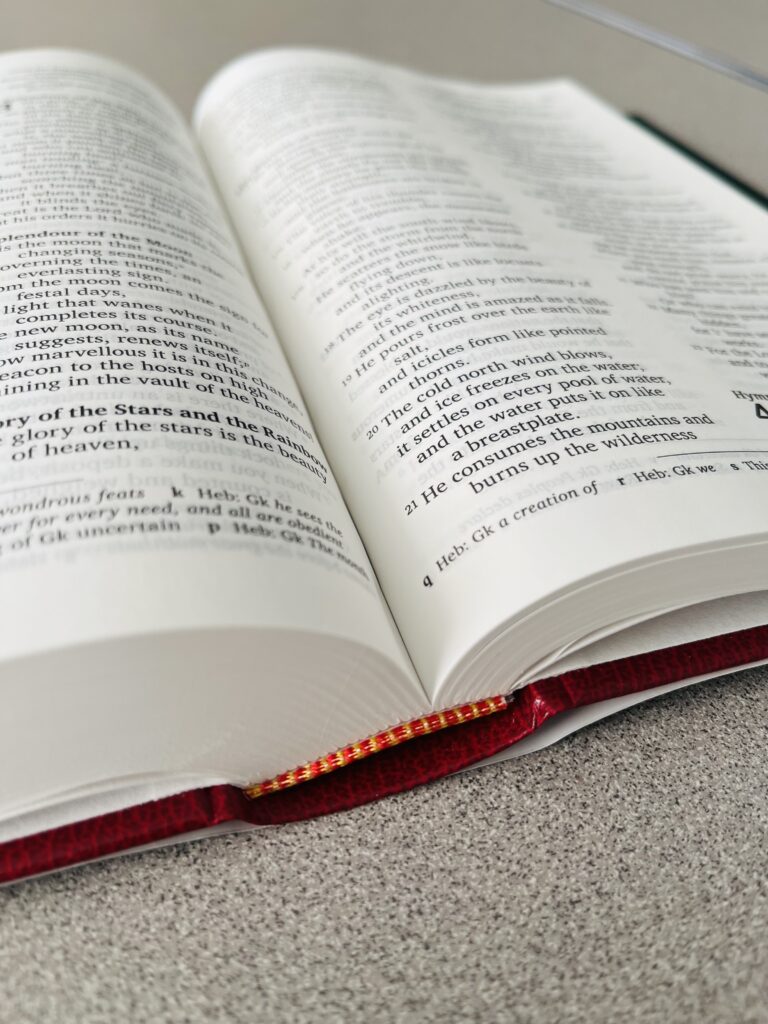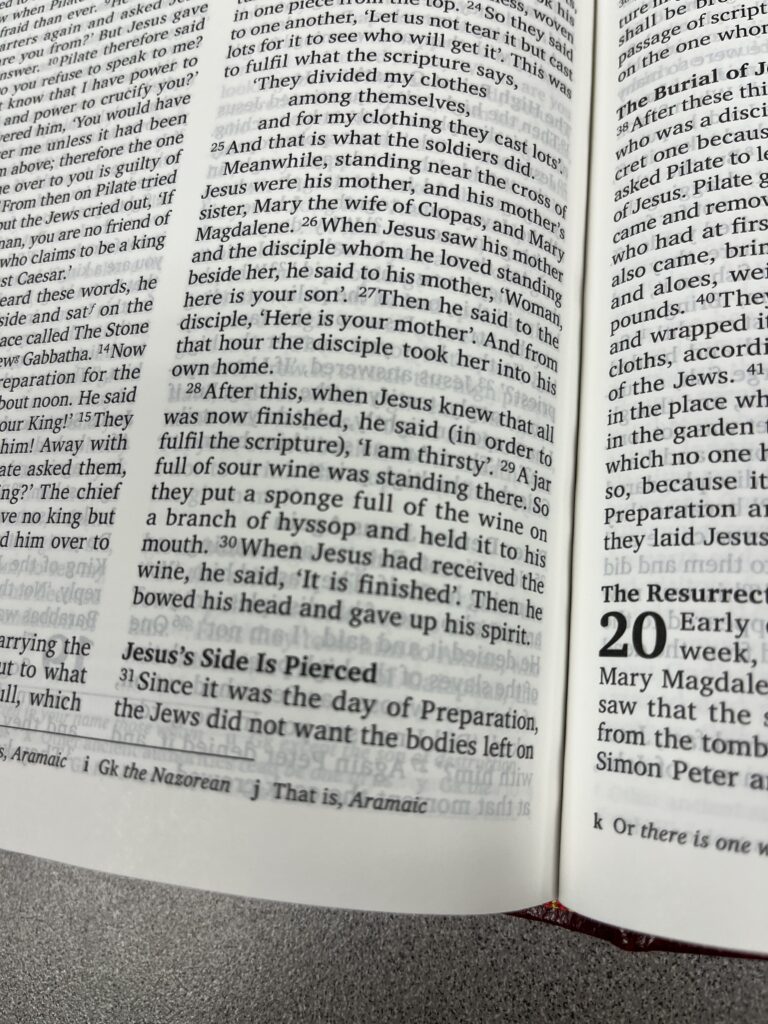
Late last year I was able to review Cambridge’s first offering in the NRSVUE translation, its edition of the Apocrypha. Up until that point, I hadn’t spent that much time looking at the updated edition of the venerable NRSV. But having spent some time perusing through various books in the NRSVUE Apocrypha, I began to look forward to what a complete edition of the NRSVUE from Cambridge would look like. The previous two offerings from Cambridge that I reviewed, the ESV Diadem w/ Apocrypha and the ESVCE Cornerstone, remain, in my opinion, the definitive premium editions of the ESV for those who desire the inclusion of the Apocrypha/Deuterocanonical books. (And yes, I am aware that the Schuyler ESV w/Apocrypha is months away.) All of this to say, I was rather intrigued with looking at Cambridge’s NRSVUE w/ Apocrypha Popular Text to see how it might compare to their more recent ESVs. Now, if you are seeking a commentary on the NRSVUE translation, there are plenty of places to find that online. I, however, will be focusing on the edition itself.

Because this edition of the NRSVUE uses the “British Text”, I will briefly note that the work of “anglicising” the NRSVUE was completed by the four main UK publishers of the NRSV: The British and Foreign Bible Society, Cambridge University Press, Oxford University Press, and the Society for Promoting Christian Knowledge. The preface notes that they met and reviewed the original work of the 1995 “anglicised” NRSV using both computer technology and group discussion to come to the results that are presented in this edition. The preface goes on to say that the “computers lack the human ear to make decisions so every change was reviewed by an editorial group meeting over video-conferencing during the era of Covid-19.” The final “British Text” was completed in 2021.

In Cambridge’s description on their website, they state that this new edition “comes in an attractive and hard-wearing burgundy hardback with gold blocking, presented in a jacket. It will be ideal for use as a church Pew Bible and in schools and colleges.” Truly, that is exactly what this edition is. The NRSVUE Popular Text w/ Apocrypha provides the reader a clear, readable text clothed in a sturdy and durable hardcover that will last. The binding, of course, is sewn. It was printed and bound in Italy by L.E.G.O. with a 2024 copyright. The dimensions are roughly 8.5” X 5.8” X 1.5”, which makes it a perfect fit for use as an individual simple reading bible for lectio divina or for purchasing in bulk for use as a classroom set. I could easily see this being found at retreat centers or in academic settings.

When you open this Bible you will immediately see that it is a very readable and clean text. The typeset is 9pt on 10 pt Charis SIL developed by the British and Foreign Bible Society. While a number of the more modern fonts that I have come across in the past few years have not been that exciting to me, I must say that I am quite enamored by what Cambridge has done here. This was not what I was expecting when I received this review copy, but I must confess that it is a delight to read. The photos here do not do it justice. The text is organized in a two column format, with bolded paragraph headings and textual notes at the bottom of the page. The bright white paper and the line-matched text make it a joy to read from. Combine that with the 1/2 inch margins, this text (even with its 9pt font) doesn’t feel cramped or cluttered. In total, there are 1568 pages in this edition, though at the beginning of each section (OT, Apocrypha, NT) they start the numbering again. The Apocrypha/Deuterocanonical books are placed between the OT and NT. I would love to see this Charis font used in future editions from Cambridge.

As mentioned above, this is a text-only bible. There are no maps, cross-references, or any other study helps. Outside of the introductory essays/prefaces from the National Council of Churches of Christ USA and the SBL, the only additional material will be a two page “Weight and Measures” section in the back of the bible. There is a presentation page at the front of this Bible. Clearly, this is designed to be a classic reader’s text.
In conclusion, if you are looking for a well-constructed edition of the NRSVUE this is the one to get. It is beautifully constructed, portable (but not compact), and designed for ease of reading. If you have been unsure about the NRSVUE but want to give it a read, I can’t think of a better edition to do that with than the NRSVUE w/ Apocrypha Popular Text. I look forward to seeing what Cambridge publishes next with the NRSVUE, including their upcoming Black Calf Split Leather edition.
I want to thank Cambridge University Press for providing me a copy of the NRSVUE w/ Apocrypha Text Edition in exchange for an honest review.
I love me a Cambridge hardcover Bible. I’ve got the New Cambridge Paragraph Bible with Apocrypha KJV and the NRSV Reference Edition with Apocrypha, both in hardcover. If I ever were to buy an NRSVue, it’d probably be this one or a future update of the aforementioned NRSV Reference Edition with Apocrypha. I’ll say, the red and black contrast makes for a very pleasant-looking dust jacket. Alas, I’m not convinced of the NRSVue, and all of the top-notch scholars whom I personally know respect have uniformly told me it’s not worth it, so I likely won’t ever get it unless the NRSVue text gets used in something else, like a commentary or whatnot.
You say the top notch scholars have said it’s not worth it, could you elaborate? I know it’s second hand info but I am curious.
I don’t want to name names, because that’d be rude, but I’m blessed to know a couple of biblical studies PhDs (ones whom people would likely know if I named them), and none of them have had anything nice to say about the NRSVue, though most of them don’t have a problem with the original NRSV. They’re all mostly NASB/ESV/CSB guys. One said the NRSVue has moved beyond simply “translating” and into the world of “superimposing modern issues over the text” instead of translating and another accused the NRSVue of “hijacking” the intent of the authors and their cultural context. And no, it’s not just that 1 Corinthians verse everyone always brings up. If this crowd thinks I should stick with the original NRSV, I’m inclined to trust them.
I would be very interested if you hear any specific examples from them. I’m curious what they are referring to. Is it the NRSVue’s use of phrases like “afflicted with paralysis” instead of “paralytic”? Or other issues? I’m genuinely puzzled about what they would find substantially different from the original NRSV.
The original NRSV gets criticized a lot for superimposing modern gender preoccupations on the text (I think there are good points on both sides of that debate), but I personally don’t find the NRSVue to be noticeably different in that general regard. I haven’t read it cover-to-cover, but I used it frequently for a while after the Zondervan personal-size NRSVue was released. I view it as a relatively restrained update to the NRSV that in some cases nudged the text in a better direction (i.e. choosing “faith of Christ” in Romans 3:22 instead of “faith in Christ” in the NRSV). Another example is 1 Cor 4:15, where the original NRSV says “…I became your father through the gospel” and the NRSVue says “I fathered you through the gospel” which seems to capture the underlying nuance of the Greek a bit better.
In general, I think “inclusive language” has no place, or only a very, very, very limited one, in Bible translation. Every time a translation (and in many ways, the 2011 NIV is even worse with the inclusive language than the 1989 NRSV) insists on avoiding male pronouns even when the pronoun is explicitly masculine in the original language, such as Psalm 1.1, they always justify it by saying “well it applies to women just as well as to men”, but is that really true? The use of inclusive language conveys the impression that biblical society was egalitarian in the same way that the modern 21st West is, but this is false, both ancient Israelite and Roman society were quite explicitly patriarchal. To suggest otherwise through inclusive language seems like an attempt to rewrite history.
I understand not wanting to name names. I wasn’t expecting that, I was just curious about critiques of the translation. I haven’t really heard much since it was initially released.
I agree, the 1989 NRSV is very PC, and I cannot imagine that the 2021 update is anything other than an escalation, taking it even further, but I would like specifics if anyone can provide any.
https://kevinrkdavisblog.wordpress.com/2023/09/10/educated-observations-on-the-nrsvue-a-second-look/
This guy does a pretty great job on his blog, and I think his comparison of the NRSV and NRSVue is the best I’ve found–as far as blogs go.
Those are interesting comments but when he talks about “bouncing around” between translations during preaching (no doubt because he is looking for a translation that goes along with whatever point he wants to make, this is another big reminder of the myriad problems with evangelicalism. The preacher should not have so much power to preach from whatever translation he wants. This comes close to a cult of personality. Not just Catholics, but also mainline Protestants have an “official” translation that is always to be read and preached from if the preacher thinks that a verse isn’t translated in the best way, he can mention this in the sermon.
Thank you for the blog. There are just too many English translations. As far as Protestant bibles go, I still prefer the REB and nothing about the NRSVue has changed my mind.
The translation situation for Catholics is kinda funny though. We piggy back off of two NCC with three different editions. Two for the RSV (CE and 2CE), which to my understanding we are the only ones still using. One for the NRSV89 whose non catholic edition is probably getting ready to be killed off. We piggy back off of an evangelical version of the RSV who’s owned by a company that dislikes Catholics. We have three in-house translation traditions, one that sells well ( I can usually find it in the top 10 at 9 or 10 in yearly sales) but everyone hates the notes and hates its plain language, the NJRB which was rejected by its home country (UK) for the ESV CE, and the NCB which is just there. Did I miss anything?
There are folks reading the Douay and Knox, too. Otherwise, yeah, good summation.
Yup I did forget to include DR and Knox. Knox is a trip.
The 1989 NRSV is not only not going to be killed off, but other than digitally it is a near impossibility to find a copy of the NRSVue.
Well, as far as the NCC is concerned it makes sense to push the NRSVUE as much as possible. Nrsv89 will linger about a bit. I can see it being another rsv in the sense that only the CE version is in use. There are so many translations that keeping nrsv89 is counter productive, just another competitor for mainline Protestant dollars. Just my opinion though
The NRSV is widely used in universities and seminaries due mostly to its wide acceptance by both Catholics and dozens of mainline Protestant denominations. It is the most ecumenical Bible in print. The NRSVue will disappear before the 1989 text does because it will probably never get the same degree of acceptance.
Entirely possible. I guess it depends on how patient the NCC can be. Can they afford to wait for acceptance or will they try to push their newest translation? The nrsv-CE isn’t going anywhere and I don’t think Catholics move the needle, and evangelicals buy, in bulk, their translations, so who else is a competitor for the nrsvue other than nrsv89? Biblical Catholic , I’m sure you have more insight into this market than I do but in any other medium you cut the old product.
Did you mean to say the NRSV? There are multiple editions of the NRSVue available and in-stock on the market, including the one Timothy reviewed in this post.
Now try to find it by anything other than a special order. Even 3 years later, I have never seen a live copy of the NRSVue in any store, every single copy of the NRSV I see in any bookstore is not only the 1989 text, but the Catholic Edition. It is hard to find anything other than the 1989 NRSV Catholic Edition in the wild.
Oh, I didn’t realize you were talking about physical bookstores. I don’t often set foot in bookstores, and when I do, I almost invariably find the Bible selection woefully limited. Used bookstores often have a wider selection than new bookstores. It’s interesting that the -UE isn’t showing up on the shelves when you’ve looked. My guess is that the primary market for the -UE will be the academic market (at least for a little while).
I don’t see an academic need for the ue, the NRSV is widely used in academia because it is accepted by almost everyone including Catholics, Jews, and Protestants. And it offers the widest possible canon, including not just Catholic deuterocanon and the additional books (3,4 Maccabees and Psalm 151) accepted by the Orthodox. The only thing they need to do is add the books from the Ethiopian canon and it will be the most ecumenical Bible ever produced, The ue doesn’t come close.
So I was just in Barnes and noble. Found me a slightly damaged rnjb that I am now giving a good home (got 20% off). It was the only Catholic Bible there. You’re right though, there was not an nrsvue to be found. Plenty of kjv, NIV, nasb, nlt, nkjv, esvs though. A lot of Qurans as well. Protestants can make some nice looking Bibles.
Amazon has a lot of them. I have a two different versions, this one is by far my favorite. It’s not cheap though.
https://www.amazon.ca/NRSVue-Bible-Apocrypha-Leathersoft-Comfort/dp/0310461499
Might as well get that nice Premier Collection edition if you’re paying that for lesthersoft!
The NRSV-CE is going to remain in print for the foreseeable future. It’s still the lectionary text of Canada and they haven’t shown any indication they’re going to change that. And Word on Fire’s Bible, which uses the NRSV-CE translation, has three more volumes to go after this year’s, meaning it will stretch to, at the earliest assuming annual releases each summer, 2027, after which the complete Word on Fire series will of course continue to be sold. The RNJB is in a state of limbo unless a bishop’s conference decides to pick it up. And of course, there’s the forthcoming NAB revision/retranslation, whose quality remains to be seen but it will obviously get strong sales via the USCCB’s backing.
As of now, the two most popular Catholic publishers seem to be Word on Fire and Ascension, due to their savvy online work, and so through them, the NRSV-CE and RSV-2CE still have a long-term future. Augustine Institute’s CSV translation is a long way off, probably not seeing the light of day in a complete Bible till the 2030s, but it’s one I won’t sleep on because, if marketed right, it could gain a following and eclipse at least the ESV-CE in the US, though that doesn’t sound like a hard task in my opinion. I’m not aware of any other Catholic translations underway.
I thought the RNJB was going to be adopted by the Aussies and NZ?
Thanks so much for posting the photos! Truly appreciated. (It’s a very liberal translation, with crazed feminist language. Hard pass.)